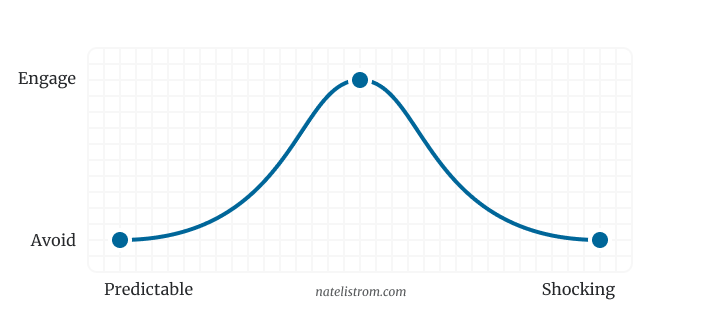Optimal difference maximizes story payoffs
Summary: The best story payoffs are neither too similar nor too different from audience expectation.
Story arcs with satisfying setups and payoffs share some key characteristics. Among them is the subversion of expectation. A story payoff doesn't need to be surprising in the traditional sense (although that doesn't hurt) but it should play on audience expectation in some way. The reason that this works is that it hooks into our brains' reward systems.
In a series of earlier posts, I explored peak aesthetic experiences, situations in which someone is exposed to a particularly meaningful work of art, music, nature, or story and experiences tears, chills, and a sense of being moved.
Just enough surprise
One key component to these experiences is optimal difference, the idea that the payoff must be neither too predictable nor too unpredictable.
“We do not feel aesthetically elated when recognizing, say, a chair. Yet, when we do not recognize objects around us or their properties, we may feel disturbed or even scared. This is a staple of thrillers: when a situation is not recognizable, one may experience horror.” (Schoeller and Perlovsky, Aesthetic Emotions section)
If things are too close to expected, they fall into the trap of failing to meaningfully subvert expectations. If a chair remains exactly where you placed it, that won’t produce strong emotion. It’s boring. Our brains’ reward systems aren’t engaged.
On the other hand, if things are too chaotic or unexpected, we can similarly struggle to engage. If a favorite dog you’ve known from a puppy one day turns and bites you, you’ll experience shock and disbelief. The event is so far out of the realm of expectation that, at first, your mind simply rejects it.
In life, we have to deal with these situations. For the dog bite, you may have to go to the hospital and get stitches. In storytelling, these moments result in the audience disengaging and going elsewhere.
The antidote? Avoid either extreme.
There appears to be an optimal point somewhere between the unmoved chair and the dog bite — a middle school crush unexpectedly slips you a private note on a folded piece of paper. At the extremes, we’re pushed away, but at this optimal point, the difference between our mental models and the phenomena we encounter is just enough to keep us engaged and experiencing a positive thrill of anticipation.

As storytellers, we want to find a comfortable place along a curve of optimal difference, some point at which things are different enough from expectation to be engaging but not so different that audiences reject them as farfetched, unbelievable, or overly melodramatic.
It’s all a matter of taste
Your audience’s taste makes a difference in what’s appropriate. Some people like experimental jazz. Others prefer pop. Some people want to try the rarest, most unique delicacies. Others stick to beef and potatoes.
In commercial fiction, varying appetites for difference are part of what makes up genre.
- Some romance and action genres tend to be very formulaic and keep close to expectations — with a few little twists to spice things up.
- Horror, though also formulaic, tends to deal in the eerie, unexpected, and shocking a lot more. There’s more appetite among horror fans for things that stretch beyond “normal.”
- In contrast to genre fiction, literary works tend to try to inject difference by intentionally avoiding formulas and conventions.
As a storyteller, the key is to understand your audience’s appetite. Where is the optimal point of difference for them? Are they more likely to be interested in a few tweaks on a familiar formula or are they hungry for something they’ve never seen before?
Rate this note
Read this next
Deus ex machina and the soul of a satisfying story ending
To be most satisfying, payoffs in stories should be set up physically, morally, and thematically.
Level-up your storytelling
Understand how stories work. Spend less time wrangling your stories into shape and more time writing them.